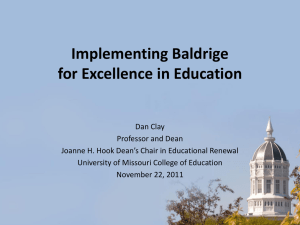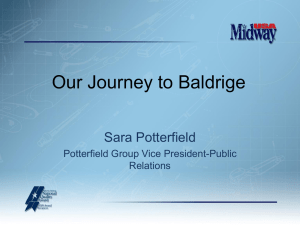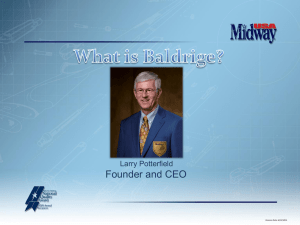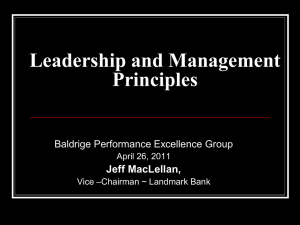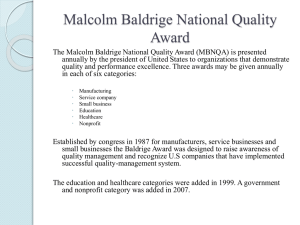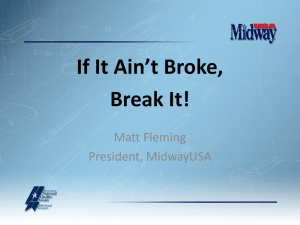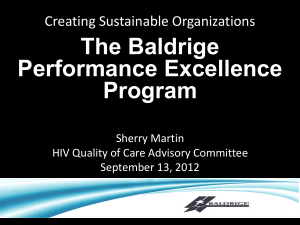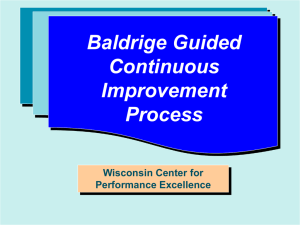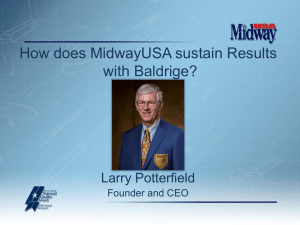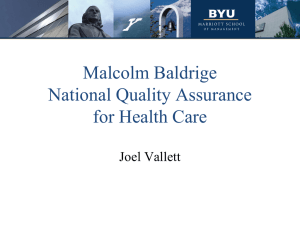The Baldrige Education Criteria for Performance
advertisement
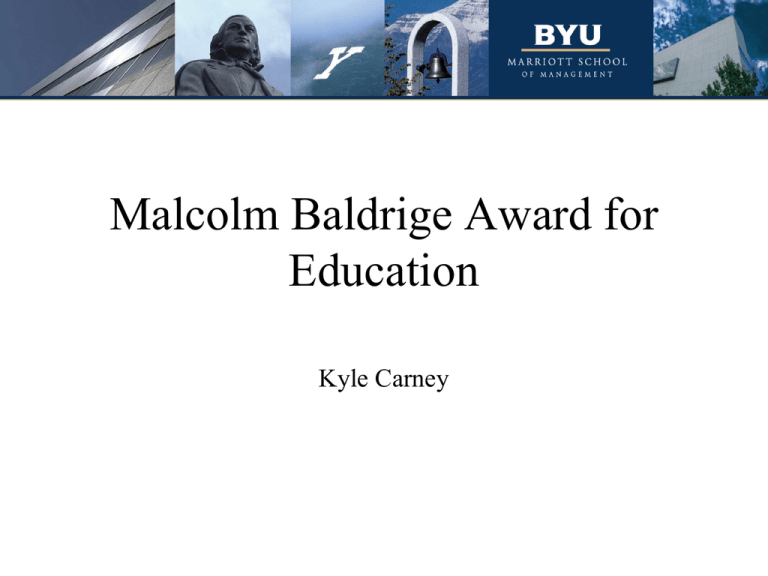
Malcolm Baldrige Award for Education Kyle Carney What Will be Covered • • • • • • • • Baldrige for Education How Can it be Used in Your Organization? Baldrige for Education: In-Depth How it works Baldrige in Action Putting it to the Test Summary Readings List Baldrige for Education • History – In the Mid 1980’s US recognizes need to improve Quality Assurance measures – Malcolm Baldrige National Quality Improvement Act of 1987 issued by US Congress – Purpose is to improve competitiveness of US businesses in a global market by: • identifying and recognizing role-model businesses • establishing criteria for evaluating improvement efforts • disseminating and sharing best practices Baldrige for Education (cont.) • History – 1999: Expanded to Healthcare and Education – 2005: Expanded to Nonprofit and Government Organizations • The Education Category has received 151 applicants since its inception in 1999 • 8 Applicants have been selected as recipients of the Award How Can it be Used in Your Organization? • Brainstorming: – Spend 5 minutes writing issues/concerns within the Education industry – Without talking, categorize each of these issues collectively – After categorizing, there should be an established list of key concerns in the industry, with specifics for each concern How Can it be Used in Your Organization? (cont.) • Brainstorming: – List established categories that were brainstormed – Take a couple minutes and think how applying for the Baldrige award can help improve each category – Discuss Baldridge for Education: In-Depth • Getting Started – Eligibility • Before Applying, must check eligibility of your firm 1. Visit Baldrige website: - http://www.nist.gov/baldrige/publications 2. Click on “Baldrige Award Application Forms” 3. Click on “Eligibility Form” 4. Proceed to fill out Word Document Baldridge for Education: In-Depth (cont.) • Getting Started – Application • To Apply your firm for the Malcolm Baldrige Award for Education: 1. Click on “Application Form” on the Baldrige website 2. Submit the form, along with: • Application Fees • Application Report How it Works • Purpose 1. Raise awareness about the importance of performance excellence in driving the U.S. and global economy 2. Provide organizational assessment tools and criteria 3. Educate leaders in businesses, schools, health care organizations, and government and nonprofit agencies about the practices of best-in-class organizations 4. Recognize national role models and honor them with the only Presidential Award for performance excellence How it Works (cont.) • What Organizations receive 1. 2. 3. 4. Feedback from team of experts Focus on organizational Improvement Opportunity to be a national role-model If selected, prestige of the Presidential Award How it Works (cont.) • After Application, Baldrige Award Examination follows in 3 stages: 1. Independent Review 2. Consensus Review 3. Site Visit Review • Not every stage is guaranteed – At the end of each stage, a judge or group of judges will review that section and determine whether or not your company progresses Baldrige Evaluation Process How it Works (cont.) • How You are Judged – Based on 7 Categories (next slide) – Each of these categories can be broken down into two dimensions: • Process – Methods your organization uses for improvement – Categories 1-6 • Results – Outputs and outcomes in achieving the requirements – Category 7 How it Works (cont.) Baldrige Education Criteria for Performance Excellence Framework How it Works (cont.) • Stage 1: Independent Review – Baldrige Application is given to an Examiner – Examiner thoroughly reviews application – Examiner judges organization based on 7 categories (previous slide) – Based on the scores, Examiner sends report for Stage 2: Consensus Review How it Works (cont.) • Stage 2: Consensus Review – Application is sent to a group of Examiners – Examiners review the organization individually – Examiners then participate in a conference call until coming to a consensus with each category – Examiners determine if organization qualifies for site visit • If not, organization is given an in-depth feedback report How it Works (cont.) • Stage 3: Site Visit – – – – Group of Examiners travel to site of organization Examiners spend 6-7 days on-site 1-2 of these days are spent alone reviewing notes Final report will be used in the determination of the Baldrige Award Winners Baldrige in Action • Richland College – Located in Dallas, TX – One of 7 community colleges in the area – First Community College in the nation to win the Baldrige Award Baldrige in Action (cont.) • Richland College – From 2002-2005, number of students to complete curriculum increased from 500 -1660 – From 2000-2005, enrollment increased by 2,000 students – Excellent leadership training: 22 of its former employees presidents at other colleges Putting it to the Test • Refer back to Richland College – http://www.baldrige.nist.gov/PDF_files/Richlan d_College_Profile.pdf • Spend 10-15 minutes filling out the SelfAnalysis Worksheet for Categories 1-2 (Leadership & Strategic Planning) as if you were Richland College Putting it to the Test • Discuss some of the strengths Richland has • What are your organization’s biggest strengths? • What are some strategies your organization can implement to emulate Richland’s success? • Set a day for your organization to thoroughly complete this worksheet for itself Summary • Malcolm Baldrige National Quality Award for Education established in 1999 • Purpose is to educate organizations in performance excellence management • Must be eligible to apply • Application process broken into 3 stages: – Independent Review – Consensus Review – Site Visit • If eligible, receive invaluable feedback from team of experts, renewed focus on organizational improvement, and potential opportunity to be a national role-model & prestige of the Presidential Award Suggested Readings/Sources • • • • Badri, Masood Abdulla, Hassan Selim, Khaled Alshare, Elizabeth E. Grandon, Hassan Younis, Mohammed Abdulla, (2006) “The Baldrige Education Criteria for Performance Excellence Framework: Empirical test and validation”, International Journal of Quality & Reliability Management, Vol. 23 Iss: 9, pp. 1118-1157 Daniels, Susan E. (2002). First to the top. Quality Progress, 35(5), 41-53. Retrieved March 27, 2011, from ABI/INFORM Global. (Document ID: 120660016) National Institute of Standards and Technology. "Baldrige by Sector: Education." Web. 27 Mar. 2011. < http://www.nist.gov/baldrige/enter/education.cfm> Ruben, Brent D., Travis Russ, Stacy M. Smulowitz, Stacey L. Connaughton, (2007) "Evaluating the impact of organizational self-assessment in higher education: The Malcolm Baldrige/Excellence in Higher Education framework", Leadership & Organization Development Journal, Vol. 28 Iss: 3, pp.230 – 250
